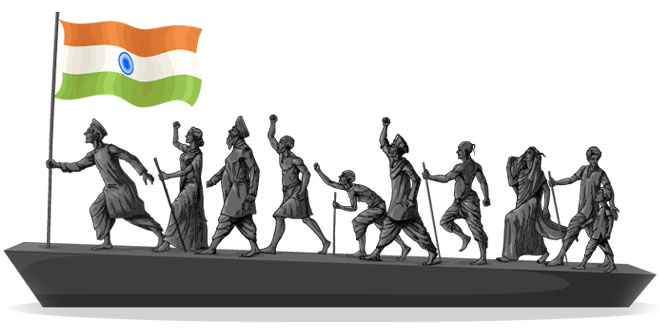Question: How was the Non-Cooperation Movement converted into a national movement by Gandhiji?
Answer:
- Hindu-Muslim Unity: Mahatma Gandhi felt the need to launch a more broad-based movement in India. He was certain that no such movement could be organized without bringing the Hindus and Muslims closer together.
- Merging Khilafat issue with the movement: So to unite the both the communities he decided to take up the Khilafat issue. The First World War had ended with the defeat of Ottoman Turkey. And there were rumors that a harsh peace treaty was going to be imposed on Ottoman emperor – the spiritual head of the Islamic world (the Khalifa).
- Talking to Muslim leaders: A young generation of Muslim leaders like the brothers Muhammad Ali and Shaukat Ali, began discussing with Mahatma Gandhi about the possibility of a united mass action on the issue. Gandhiji saw this an opportunity to bring Muslims under the umbrella of a unified national movement. At the Calcutta session of the Congress in September 1920, he convinced other leaders of the need to start a non-cooperation movement in support of Khilafat as well as for Swaraj.
Question: “The effects of Non-cooperation on the economic front were more dramatic.” Explain. Or Explain the effects of Non-Cooperation Movement on the economic front. Or Explain the impact of Non-Cooperation Movement in the economic field.
Answer:
- Fall in imports: Foreign goods were boycotted, liquor shops picketed, and foreign cloth burnt in huge bonfires. The import of foreign cloth halved between 1921 and 1922, its value dropping from Rs. 102 crore to Rs. 57 crore.
- Boycott of Foreign goods: In many places merchants and traders refused to trade in foreign goods or finance foreign trade.
- Boost for Indian industry: As the boycott movement spread, and people began discarding imported clothes and wearing only Indian ones, production of Indian textile mills and handlooms went up.
Question: Who formed the Swaraj Party? Why was the party formed?
Answer: The Swaraj Party was formed by C.R. Das, and Motilal Nehru. The Non cooperation movement failed to achieve its objective of Swaraj. So within the Congress some leaders were by now tired of mass struggles and wanted to participate in elections to the provincial councils that had been set up by the Government of India Act of 1919. They felt that it was important to oppose British policies within the councils, argue for reform and also demonstrate that these councils were not truly democratic. C.R. Das and Motilal Nehru formed the Swaraj Party within the Congress to argue for a return to council politics.
Question: What were the factors responsible for the gradual slow down of the NonCooperation movement? Or Why did the Non-Cooperation Movement gradually slow down in the cities? Give reasons.
Answer:
- Expensive Khadi: The Khadi cloth was often more expensive than the mass- produced mill cloth and poor people could not afford to buy it.
- No alternative: The boycott of British institutions posed a problem. For the movement to be successful, alternative Indian institutions, had to be set up so that they could be used in place of the British institutions but these were slow to come up. So students and teachers had no option except joining back government schools, and lawyers joined back work in government courts.
- Local movements with different interpretation: Workers, industrialists, peasants, traders had their own understanding, of Gandhiji’s notion of ‘Swaraj.’ They started using violent methods for their demands. All this was not approved by Gandhiji and the Congress. So the movement started losing its shine.
Question: Describe briefly any three economic effects of the Non-Cooperation Movement.
Answer:
- Boycott of foreign goods: People decided to boycott foreign goods and wear Swadeshi clothes, and use Swadeshi goods.
- Impact on imports: As people began discarding imported clothes, the import of foreign clothes halved between 1921 and 1922. Its value dropped from Rs 102 crore to Rs 57 crore.
- Impact on Indian industry: As people decided to boycott foreign clothes, production of Indian textile mills and hand-loom went up.
Question: What were circumstances which led to Jallianwala Bagh incident? Describe in brief the reaction of the people immediately after the incident. Or Explain the impact of Jallianwala Bagh incident on the people.
Answer:
- Rowlatt Act: The Rowlatt Act was passed by the government despite the united opposition of the Indian members. The act gave enormous powers to the police to arrest any one without any trail.
- Rowlatt Satyagraha: Gandhiji decided to launch Rowlatt Satyagraha. Rallies were organised in various cities, workers went on strike, and shops were closed down. Alarmed by the popular upsurge, British government decided to arrest Indian leaders. Local leaders were picked up from Amritsar and Delhi.
- Martial Law: Seeing the people’s reaction against the arrest of their leaders police imposed Martial law in Amritsar. On 13th April 1919 General Dyer fired at the people who had gathered in Jallianwala Bagh killing many. People’s Reaction: (1) As the news spread, crowd took to the streets in many north Indian towns. (2) There were strikes, clashes with the police and attack on government buildings.
 Class Notes NCERT Solutions for CBSE Students
Class Notes NCERT Solutions for CBSE Students





